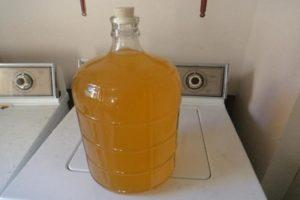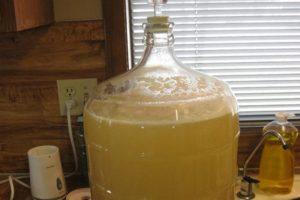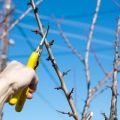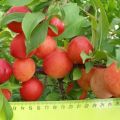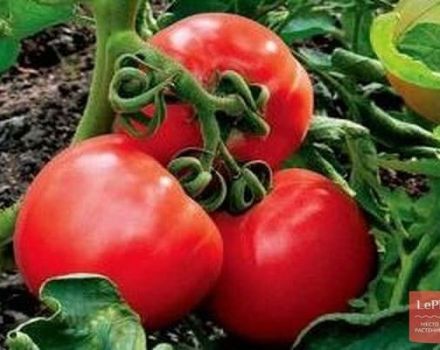TOP 13 step-by-step recipes for making plum wine at home
Wine made from homemade plums cannot be considered elite, but if the recipe is followed, the drink turns out to have a pleasant aroma and excellent taste. Its characteristics are suitable for both meat and sweet dishes. For gardeners, the problem of excess harvest is solved, and for the holiday there is always a high-quality drink without artificial colors, flavors and flavor enhancers. Plum fruits contain a large amount of sugars, due to which the fermentation process is quick and requires almost no sugar addition.
The benefits and harms of plum wine
The wine made from plums has the beneficial properties of the original product. It is rich in trace elements, minerals, vitamins and tannins. Moderate consumption of the drink helps to normalize metabolism, normalizes metabolism, and is an effective means of preventing diseases such as:
- diabetes;
- diseases of the gastrointestinal tract;
- cardiovascular diseases.
Wine made from yellow plums is also characterized by hypoallergenic properties.
The drink does not harm the human body only if consumed in moderation. In case of abuse, like any alcohol, it causes irreparable harm to the circulatory and digestive systems, contributes to a deterioration in the general appearance of a person, and causes addiction.
Cooking specifics
The hardest part of making homemade plum wine is the juicing procedure. They are preliminarily removed from seeds and processed in any available way into a puree mass. If the seeds are not removed, the drink will acquire a bitter unpleasant aftertaste.
During fermentation, it is required to regulate the amount of granulated sugar, as well as to control its flow using the installed water seal.
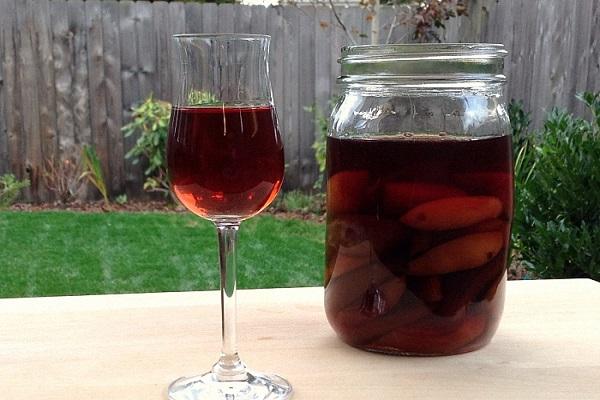
How to choose the right ingredients
Collecting plums for making wine is carried out at a time when the fruits just began to fall from the tree. After that, they are left for several days to ripen, spread out on a tray under the sun. You cannot wash them so as not to destroy the formed yeast.
Rotten or green fruits, which can significantly impair the taste of the prepared drink, should not be used for winemaking.
They should be ripe and juicy.
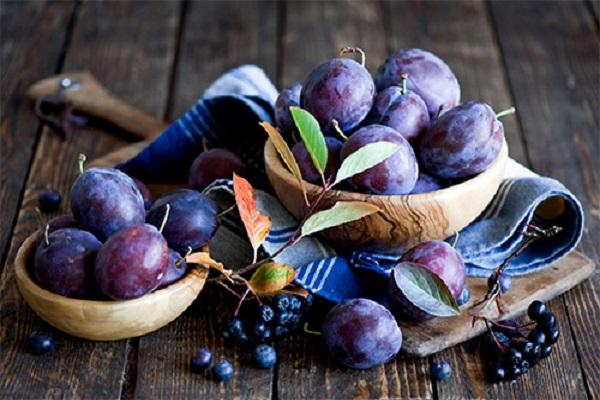
How to make plum wine at home
Each experienced gardener has his own proven recipe for making plum.These techniques are constantly being improved, refined and changed, as a result of which more advanced cooking technologies appear.
Classic recipe
This method is popular with winemakers due to its simplicity and versatility. You will need the following ingredients:
- ripe fruits of plums in any quantity;
- clean water - 1 liter per 1 kg of peeled fruits;
- sugar - from 120 to 370 g per 1 liter of cooked wort.
A step-by-step cooking recipe is as follows:
- Sort ripe plums, but never wash.
- Squeeze bones out of them in any convenient way.
- Puree the pulp.
- Add clean water, stir and place in a fermentation vessel.
- For a couple of days, the vessel is left at a temperature of +25 C in a dark room.
- The wort is stirred several times a day.
- As soon as foam and characteristic hissing appear, the wort is filtered and sent to the fermentation vessel, adding 0.5 of the required amount of sugar.
- Put the container in a warm place, having previously installed a water seal.
- After 7 days add another 25% sugar.
- After a couple of months, fermentation stops, after which the finished wine should be filtered.
The finished product is put to ripen in a dark cool cellar in a tightly sealed container. After a couple of months it can be consumed.

The easy way with bones
You can make delicious wine from the following set of ingredients:
- ripe fruits - 5 kg;
- clean water - 1 liter per 1 kg of fruit;
- granulated sugar - from 100 to 3000 g per 1 liter of finished wort.
Get rid of the seeds in an accessible way, crush half of them and take out the kernels. The remaining half can be thrown away. Convert the pulp into puree and dilute with cold water. Throw sugar there in the ratio of 50 g per 1 liter of liquid and nucleoli. Cover the dish with a cloth and place in a warm place for 3 days. Periodically, the entire mass must be mixed.
Next, the cake is filtered and squeezed, and the pure juice is sent to a fermentation vessel, pouring out another part of the sugar and installing a water seal. Keep the container warm throughout the period. The finished drink is decanted, corked and allowed to ripen in a dark cool room.
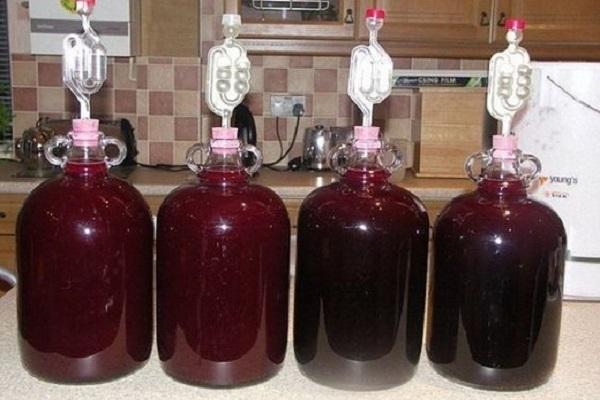
From plum jam
Wine can be made not only from fresh plums, but also from jam. This will require:
- plum jam - 500 ml;
- pure still water - 500 ml;
- granulated sugar - 50 g.
Place the jam in a three-liter jar, add water there, pour out some of the granulated sugar and stir everything. Put on a medical glove on the neck and put the container in a warm place. As soon as the cake is on the surface, it is carefully removed and the second part of the sugar is added. When carbon dioxide stops escaping, the wine is filtered. It is sent for ripening in a cool place tightly sealed.

From compote
Experienced gardeners are familiar with the process of making homemade wine from fermented plum compote. Required Ingredients:
- plum fruit compote - 1.5 l;
- granulated sugar - 50 g;
- clean water - 0.5 l;
- dark raisins - 25 g.
Separate 1 glass of liquid from strained compote and put it on low heat. Pour in raisins and some granulated sugar, remove from heat and leave for several hours. Mix the resulting sourdough with the main liquid, pour into a fermentation container. Leave it warm, covered with a water seal. Grate the fruits removed from the compote with the second part of granulated sugar and simmer over low heat.
Allow to cool, place the fruits in a separate jar, pour in water, pull on a medical glove and put in a warm place. After the carbon dioxide ceases to be released, carefully strain the wine from both cans, mix it and send it to ripening.
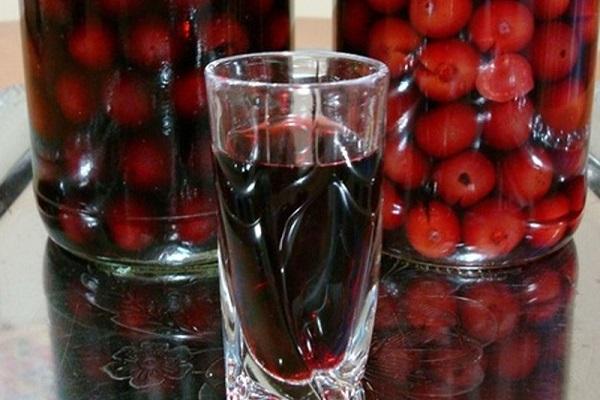
From prunes
Homemade prune wine is made from the following ingredients:
- fruits - 3.5 kg;
- sugar - 0.5 kg;
- water - 0.5 l.
Separate the seeds from prunes in any convenient way. Fold the fruits into a large glass container.Pour water there and wait until the mass ferments. After a week, strain the mass, add sugar to the resulting juice and leave it warm under a water seal for fermentation. As soon as carbon dioxide ceases to be released, carefully drain from the sediment, pour into a clean glass container and send for ripening.

Option without water
Plum wine ferments without the addition of water. To prepare it you will need:
- ripe plum fruits - any quantity;
- sugar - 300 g per 1 liter of wort.
Do not wash plum fruits, knead them thoroughly without removing the seeds. Pour everything into a clean container, cover with a cloth and leave warm for several days. Stir the wort periodically. After a few days, it is filtered and the required amount of granulated sugar is added. After that, pour into a suitable glass jar, put on a medical glove on top and leave it warm. After carbon dioxide ceases to evolve, carefully drain from the sediment and send for maturation in a cool cellar in a glass container.

Frozen plum
For cooking you will need:
- plum juice from frozen fruits - 1.5 l;
- clean water - 1.5 l;
- sugar - 125 g;
- dark raisins - 50 g.
Cooking method:
- Mix plum juice and water in a clean bowl and heat slightly (no more than 30 FROM).
- Stir the liquid with granulated sugar and pour into a glass bottle.
- Throw raisins into the same container.
- Put on a medical glove on the neck and leave warm.
- As soon as carbon dioxide ceases to be released, carefully drain the wine from the sediment and send it to maturing in a cool cellar.
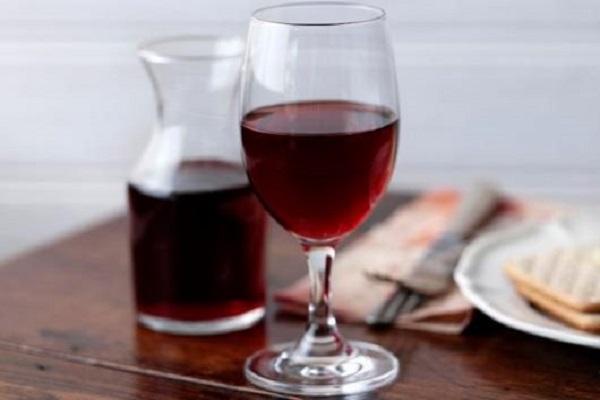
With apples and berries without yeast
A drink is prepared from the following ingredients:
- ripe plum fruits - 1.5 kg;
- sweet variety of apples - 1.5 kg;
- clean water - 3 liters;
- sugar - 450 g
Cooking method:
- Remove seeds from plums, apples from cores and knead them thoroughly by adding 1 liter of water and 350 g of sugar.
- Strain the resulting mass, add the remaining sugar and pour in water, put under a water seal.
- When carbon dioxide completely ceases to evolve, carefully drain the finished wine from the sediment and send it to a cool room for ripening.
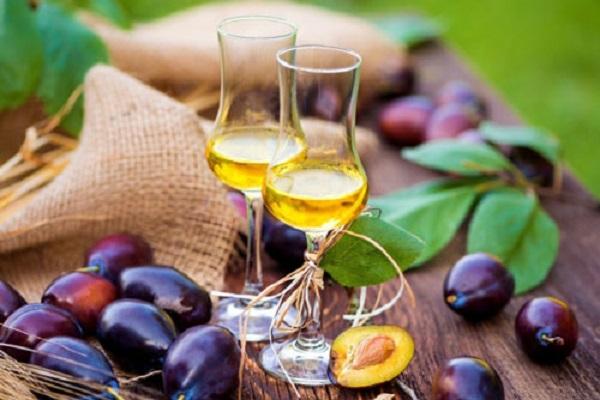
From yellow plum
Light wine is made from the following components:
- yellow plum fruits - 5 kg;
- clean water - 3.5 liters.
Cooking method:
- Mash the plums, add water and wait until fermentation begins, stirring the wort from time to time.
- After a few days, strain the entire mass and place the resulting juice under a water seal.
- After a month, gently decant the finished wine from the sediment and send it to the cellar.
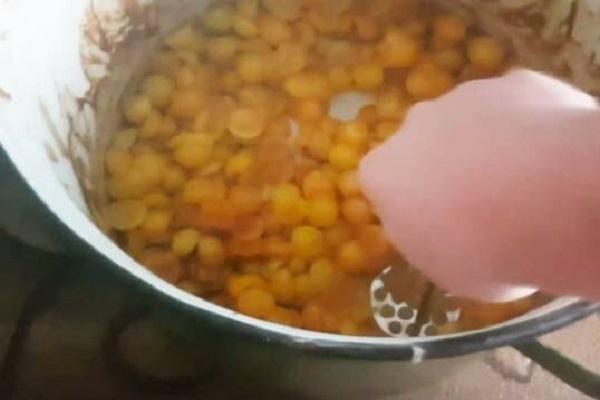
On vodka
You can prepare an original drink from the following components:
- ripe plum fruits - 0.5 kg;
- clean water - 1 liter;
- granulated sugar - 200 g;
- vodka - 125 ml.
Cooking method:
- Prepare syrup with half granulated sugar and water.
- Pour the crushed plum fruits with syrup cooled to room temperature and leave for 8 hours.
- Drain the syrup from the plums into a glass container, and prepare a new portion to pour the fruit.
- After another 8-10 hours, remove the plums, pour vodka into the resulting liquid and let it brew for 14 days.
- Drain the wine from the lees and place in the cellar.
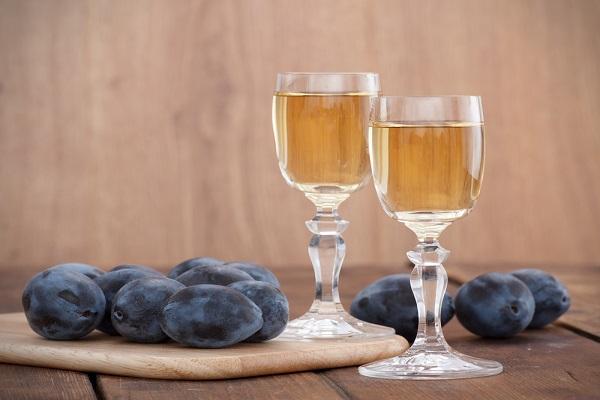
Wine yeast
Delicious homemade plum wine is made from the following ingredients:
- ripe plum fruits - 3.5 kg;
- granulated sugar - 2 kg;
- clean water - 2 liters;
- wine yeast - 75 g.
Cooking method:
- Remove seeds from fruits and turn into puree, add water and sugar.
- After 3 days, strain the wort and pour the resulting liquid into a fermentation container.
- Add wine yeast, place under a water seal and wait until fermentation ends.
- Drain the wine from the lees and send to mature in the cellar.
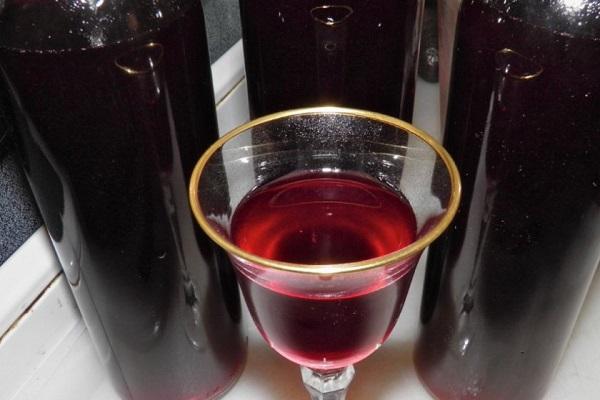
Fortified plum wine
Ingredients for making wine:
- overripe plums - 1 kg;
- purified water - 2 l;
- vodka - 0.25 l;
- sugar - 400 g
Cooking method:
- Pitted plums are placed in a glass container.
- Syrup is boiled from water and sugar and the fruits are poured over them, leaving to infuse for 8 hours.
- The syrup is drained, boiled again and the plums are poured over it again.
- Vodka is added to the plums filled with syrup.
- Put a water seal or a rubber glove on the dish and leave it in a warm room for 2 weeks.
- As soon as carbon dioxide ceases to be released, the finished wine is carefully drained from the sediment and left to ripen in a cool place.
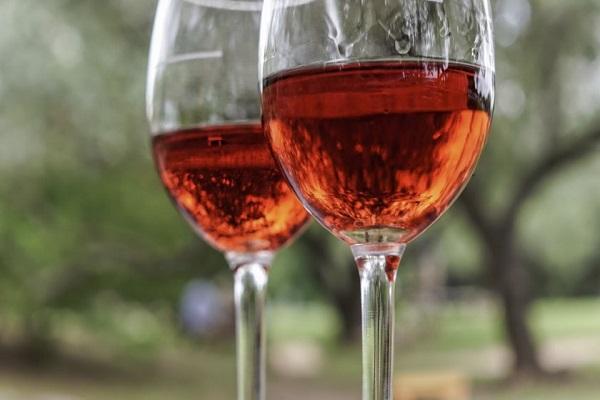
From juice
Plum juice wine is made from the following components:
- overripe plum fruits - 4 kg;
- clean water - 0.5 l;
- granulated sugar - 150 g.
Cooking method:
- Pass the plums through a juicer or use some other available method to juice them.
- The resulting juice is mixed with water and sugar.
- Stir everything thoroughly and place it under a water seal.
- After the carbon dioxide stops emitting, the wine is carefully drained and sent to the cellar.
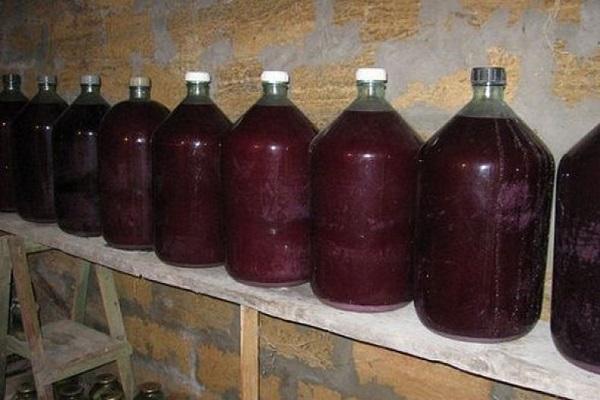
Storage rules
For storing homemade plum wine, it is better to use glass bottles with a volume of 0.75 liters. It is recommended to place the sealed container in the cellar on the north side. The air temperature there is maintained at +14 C. The cork must be tightly closed during the entire storage period so that the wine does not deteriorate and does not lose its quality.
The container should not be exposed to vibrations or shocks.
